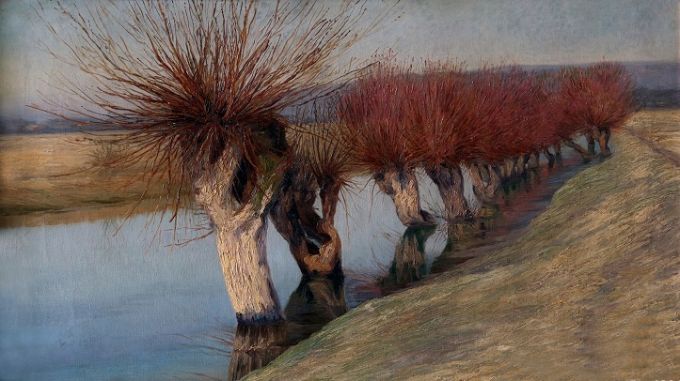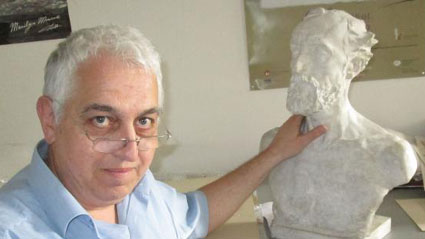 3
3
КVADRAT 500 (Quadrant 500) National Art Gallery has for the first time presented its complete collection with 26 works by artists from Croatia, Serbia and Slovenia who 110 years ago joined the Sofia-hosted display of “Lada” Union of South Slavic Artists. The union was founded in 1904 at the initiative of renowned Serbian sculptor Đorđe Jovanović and its goals were to play an essential role in building cultural values of the Balkan Slavic nations, change the course of Balkan plastic art and oppose a few skeptics. Most of these goals were attained and beyond any doubt the Union of South Slavic Artists left a worthy vestige in the history of 20 c. European cultural exchange.
Back in 1906 Sofia hosted a meeting of vanguard brainworkers and artists from four young Balkan cultures including outstanding historians, archeologists and writers. The meeting was set to begin work for the recognition of these fledging cultures by the rest of European schools of knowledge and art and to show self-confidence. The curator of the exhibition Kalin Nikolov says more about the meeting that took place 110 years ago:
 „This is a remarkable page in the history of the European cultural horizon. Small nations are sometimes reluctant to see culture as an open system, as a shared garment of mankind standing for its entire imagination and its view about the Universe, the tangible and the intangible. At the beginning of 20 c. thanks to a lucky chance Bulgarians had the opportunity to join the Union of South Slavic Artists. The honorary chairman of this remarkable movement was Czech artist of genius Jaroslav Vesin who at that time lived and worked in Bulgaria.”
„This is a remarkable page in the history of the European cultural horizon. Small nations are sometimes reluctant to see culture as an open system, as a shared garment of mankind standing for its entire imagination and its view about the Universe, the tangible and the intangible. At the beginning of 20 c. thanks to a lucky chance Bulgarians had the opportunity to join the Union of South Slavic Artists. The honorary chairman of this remarkable movement was Czech artist of genius Jaroslav Vesin who at that time lived and worked in Bulgaria.”
Vanguard art movements at that time such as impressionism, neoimpressionism, secessionism and expressionism were more or less foreign to Bulgarian culture.
„The foremost Bulgarian journalist, historian and diplomat Simeon Radev when writing about the presentation of Slovenian artists to Bulgarian viewers reports: 'We saw many visitors laughing at the works… With the same laughter French audiences met the first landscapes of impressionists a few decades ago.' This event was a constructive way for art to depart from the shadow of academic templates and from the sham of pseudo-classical illustrations. On this occasion Bulgarian intellectuals and artists demonstrated eagerness to embrace European trends in modern art.”
The works of Bulgarian impressionist Nikola Petrov provide a worthy example of this pursuit. He painted "St. Sophia" Church, Lions' Bridge and the "Ivan Vazov" Theatre, selecting themes showing that Europe had already entered the Bulgarian capital. He was interested in city noise and traffic: the same subjects that influenced modern art in Paris, Munich and London at that time. This shows how very important the early 20 c. was for Bulgarian fine art.
„We should never dwarf the achievements of Balkan countries. We should be cross with ourselves over that the world is not familiar with our great artists - after all we too know little about them. This is the enigma of the problem. So this exhibition is a way to revisit the first encounter of Bulgarian culture with modern art 110 years ago.”
English Daniela Konstantinova
The short animated film "Life with an Idiot" by Theodore Ushev won the best film award at the Beijing International Short Film Festival. The animator announced the news on his Facebook profile. "I am very happy because it is..
The Vladigerov brothers will provide a live musical accompaniment to a silent film at Vienna’s Metro Kulturhaus cinema , marking their second time taking on the challenge. The historic Metro Kino has been run by the Austrian Film Archive since 2002,..
The film “Made in EU” by director Stefan Komandarev won the Audience Grand Prize at the 63rd Gijón International Film Festival in Spain. The film triumphed in competition with 95 titles, BTA has reported. “Within a few days, we..
The Vladigerov brothers will provide a live musical accompaniment to a silent film at Vienna’s Metro Kulturhaus cinema , marking their second time taking..
The film “Made in EU” by director Stefan Komandarev won the Audience Grand Prize at the 63rd Gijón International Film Festival in..
The short animated film "Life with an Idiot" by Theodore Ushev won the best film award at the Beijing International Short Film..

+359 2 9336 661
